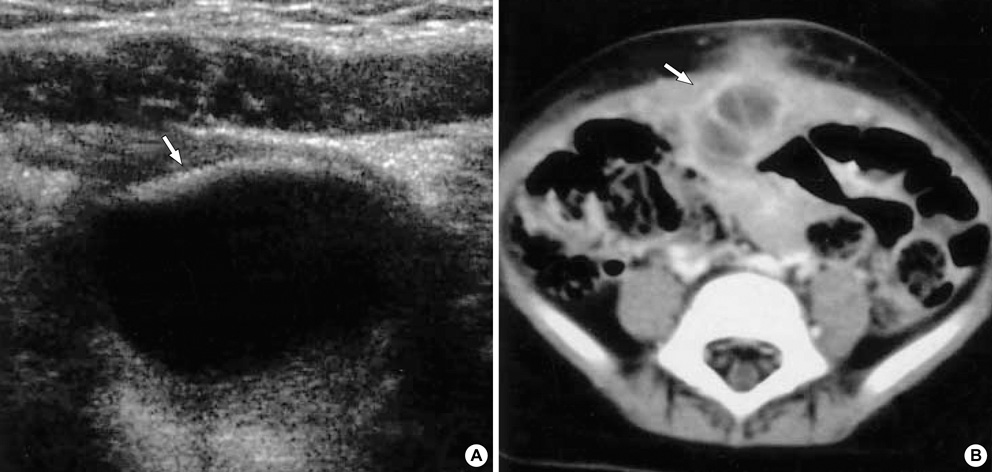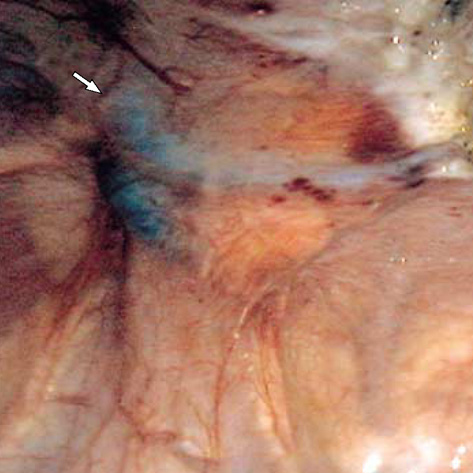J Korean Med Sci.
2006 Apr;21(2):361-364. 10.3346/jkms.2006.21.2.361.
Laparoscopic Management of Complicated Urachal Remnant in a Child
- Affiliations
-
- 1Department of Urology, Konkuk University Chung-ju Hospital, Chungju, Korea. hskim@kku.ac.kr
- 2Department of Surgery, Konkuk University Chung-ju Hospital, Chungju, Korea.
- 3Department of Urology, Eulgi University College of Medicine, Deajeon, Korea.
- KMID: 1781852
- DOI: http://doi.org/10.3346/jkms.2006.21.2.361
Abstract
- A few cases of laparoscopic surgery for urachal remnant in children has been reported in English literature. With recent developments in minimal invasive surgery, laparoscopic approach for urachal remnant in adulthood is recommended by some laparoscopic surgeons because of its technical feasibility and safety as well as cosmesis. Recently we experienced a case of complicated urachal remnant in a 14-month-old girl, who was managed by laparoscopic approach. At presentation, she complained of high fever and lower urinary tract symptoms. After 6 weeks of antibiotics therapy, laparoscopic surgery was performed transperitoneally via 3 ports. Our experience suggests that laparoscopic excision of urachal remnant can be performed easily and safely in children.
Keyword
MeSH Terms
Figure
Reference
-
1. Siegel JF, Winfield HN, Valderrama E, Smith AD. Laparoscopic excision of a urachal cyst. J Urol. 1994. 151:1631–1633.2. Stone NN, Garden RJ, Weber H. Laparoscopic excision of a urachal cyst. Urology. 1995. 45:161–164.
Article3. Cadeddu JA, Boyle KE, Fabrizio MD, Schulam PG, Kavoussi LR. Laparoscopic management of urachal cysts in adulthood. J Urol. 2000. 164:1526–1528.
Article4. Bauer SB, Retik AB. Urachal anomalies and related umbilical disorders. Urol Clin North Am. 1978. 5:195–211.
Article5. Scheye T, Vanneuville G, Amara B, Francannet P, Dechelotte P, Campagne D. Anatomic basis of pathology of the urachus. Surg Radiol Anat. 1994. 16:135–141.
Article6. Berman SM, Tolia BM, Laor E, Reid RE, Schweizerhof SP, Freed SZ. Urachal remnants in adults. Urology. 1988. 31:17–21.
Article7. Goldman IL, Caldamone AA, Gauderer M, Hampel N, Wesselhoeft CW, Elder JS. Infected urachal cysts: a review of 10 cases. J Urol. 1988. 140:375–378.
Article8. Blichert-Toft M, Nielsen OV. Diseases of the urachus simulating intra-abdominal disorders. Am J Surg. 1971. 122:123–128.
Article9. Henly DR, Farrow GM, Zincke H. Urachal cancer: role of conservative surgery. Urology. 1993. 42:635–639.
Article10. Sheldon CA, Clayman RV, Gonzalez R, Williams RD, Fraley EE. Malignant urachal lesions. J Urol. 1984. 131:1–8.
Article11. Khurana S, Borzi PA. Laparoscopic management of complicated urachal disease in children. J Urol. 2002. 168:1526–1528.
Article






